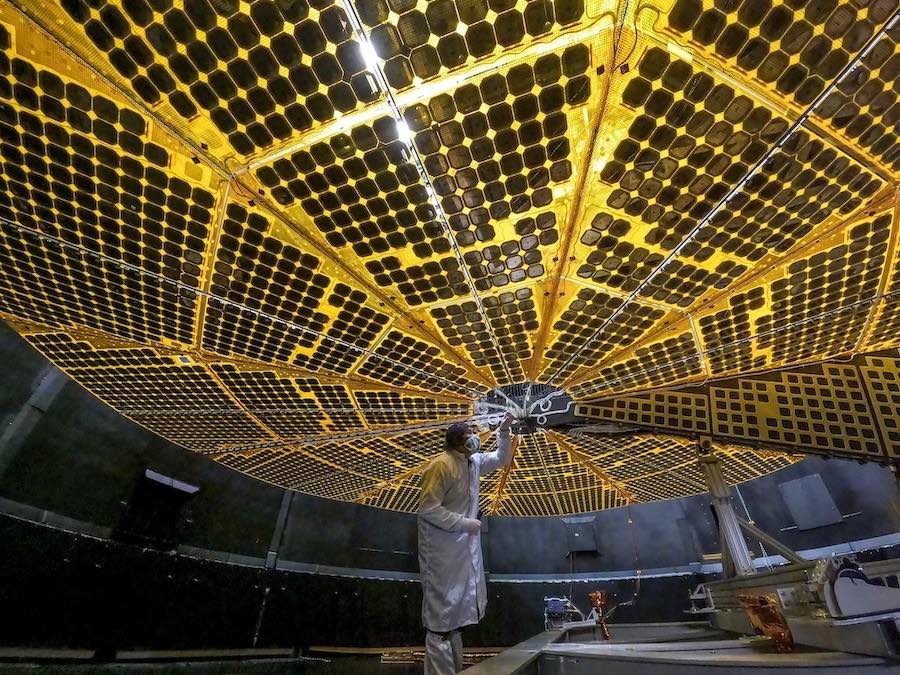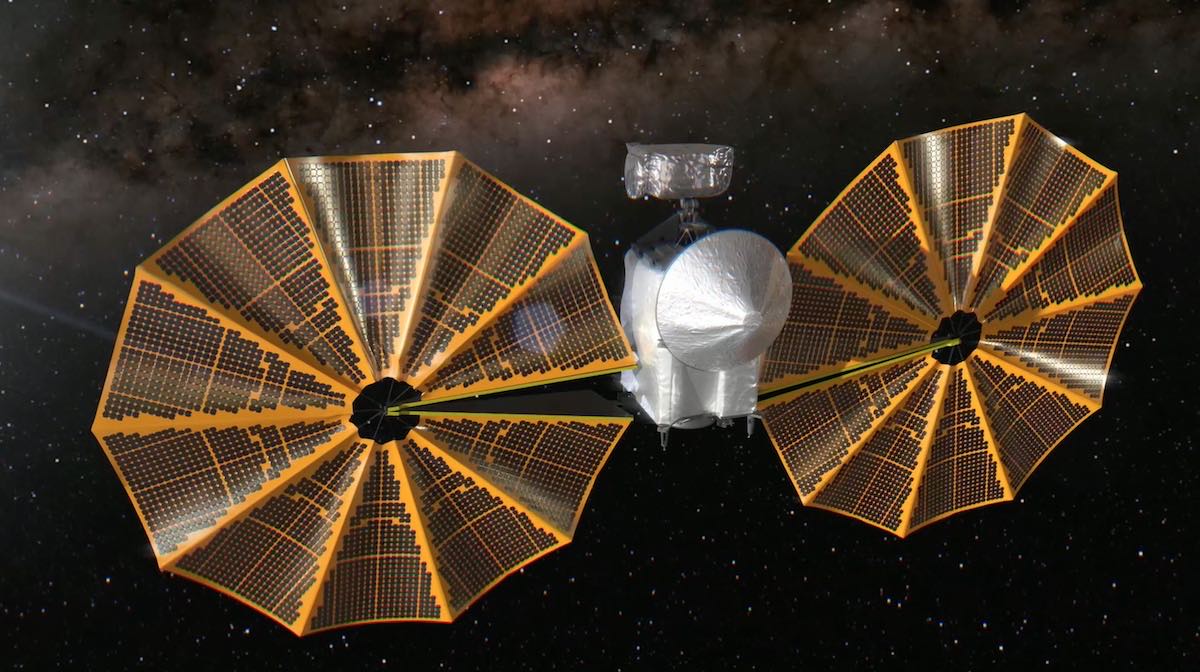
Engineers have made progress in attempts to fully unfurl a solar array wing that snagged on NASA’s Lucy asteroid explorer shortly after launch last October, adding to optimism that the spacecraft can complete its 12-year mission as planned.
One of Lucy’s two UltraFlex circular solar arrays opened to about 96% of its fully deployed state after arriving in space last October following a launch from Cape Canaveral. The other solar array fully unfurled as the spacecraft began a robotic science mission to fly through swarms of unexplored asteroids that lead and trail Jupiter in its orbit around the sun.
In recent weeks, ground teams at a Lockheed Martin control center in Colorado have uplinked commands for Lucy run primary and backup motors to drive the stuck solar array closer to full deployment.
NASA believes a lanyard used to pull the solar array open somehow lost tension and fell off a spool during the initial deployment last October, preventing the array from completely opening.
Additional attempts to pull the solar array open have further reeled in the lanyard. The first try May 9 involved running the deployment motors in a series of short intervals to avoid overheating. Ground controllers sent more commands May 12, further advancing the solar array deployment and adding tension to the structure, helping stabilize the array.
Engineers made more progress during two additional deployment attempts May 26 and June 2. “While the array still did not latch, the data indicates that it continued to further deploy and stiffen throughout the attempt,” NASA said.
Most recently, the Lucy ground team sent another command to run the deployment motors June 9, which continued to “further stabilize the array,” NASA said. “There are future opportunities to repeat the deployment commands if necessary.”
Officials are increasingly optimistic that the Lucy mission can proceed without any issues, even if the solar array does not latch into place. Before the recent tries to fully deploy the array, the spacecraft’s power system was generating more than 90% of the expected level of 18,000 watts.
“While there is no guarantee that additional attempts will latch the array, there is strong evidence that the process is putting the array under more tension, further stabilizing it,” NASA said in a statement. “Even if the array does not ultimately latch, the additional stiffening may be enough to fly the mission as planned.”
“We are seeing significant tensioning of the array,” said Hal Levison, Lucy’s principal investigator from the Southwest Research Institute. “These things are made out of cloth, and where you get a lot of the strength is by putting it under tension. And we’re clearly at a point where we’re tensioning the array, which makes it likely, even if we don’t get the thing latched, we’ll be able to fly the mission as is.”
One concern engineers have studied is the effect of engine burns on the partially deployed array. The Lucy spacecraft completed its first trajectory correction maneuver June 7 to help guide it toward a flyby with Earth in October, the first of multiple gravity assists to slingshot the probe toward Jupiter’s orbit in the distant solar system.
Lucy has also extended the platform holding its scientific instruments, and the sensors are all working as designed, Levison said.

Lucy will become the farthest spacecraft from the sun to ever rely on solar power, reaching a maximum distance of 530 million miles (853 million kilometers), nearly six times farther than Earth’s orbit. When it reaches the Trojan asteroids, Lucy’s solar arrays were expected to generate just 500 watts of power.
That level of power output is sufficient to feed Lucy’s three science instruments, which only need about 82 watts of power during each asteroid encounter. Lucy’s flight computer, communications system, and other components will also draw on power generated by the UltraFlex arrays.
The $981 million Lucy Mission is the first to explore the Trojan asteroids, which scientists say are leftover building blocks similar to objects that came together to form the solar system’s giant outer planets. The probe will fly by eight Trojan asteroids between 2027 and 2033, plus one object in the main asteroid belt in 2025.
That’s one more asteroid than scientists expected Lucy to visit when it launched last year.
One of the Trojan asteroids on Lucy’s tour, named Polymele, has a companion. Scientists discovered an apparent satellite of Polymele during a ground-based occultation observation in March, when Polymele briefly passed in front of a star, temporarily blocking its light from reaching Earth.
The occultation observations were intended to help the Lucy science team determine the shape of Polymele, which only appears as a point of light in telescope images.
“We got a really nice projected shape of Polymele, and then we were very surprised to detect an object about 200 kilometers (120 miles) away from Polymele,” Levison said last week in a presentation to NASA’s Small Bodies Advisory Group. “It’s 5 kilometers (3 miles) in diameter, and it’s sitting almost exactly in Polymele’s equatorial plane.”
Lucy’s science team has temporarily named the object Shaun, after “Shaun the Sheep” in the show “Wallace and Gromit.”
More data on the object’s exact position and orbit are required to assign a permanent name to Polymele’s companion, and that probably won’t happen until after Lucy’s flyby in 2027.
Polymele itself has an “oblate spheroid,” or gourd-like, shape and measures about 17 miles (27 kilometers) long and 8 miles (13 kilometers) wide. The shape of Polymele suggests it is likely a leftover remnant from the young solar system more than 4.5 billion years ago, and may have avoided any collisions with other objects throughout its history.
“It’s hard to imagine you can get that shape … out of an object that’s collisionally evolved, so my thinking right now is Polymele is probably a primordial object, which is going to make seeing it really fascinating.”
Polymele’s companion is not the first asteroid to be added to Lucy’s flight plan since the mission was approved by NASA in 2017. Astronomers announced in 2020 that observations with the Hubble Space Telescope confirmed a small object, less than 1 kilometer in diameter, orbiting asteroid Eurybates, another Lucy target in the Trojan belt.
Email the author.
Follow Stephen Clark on Twitter: @StephenClark1.
from Spaceflight Now https://ift.tt/ZY5UzlQ
via World Space Info







0 comments:
Post a Comment